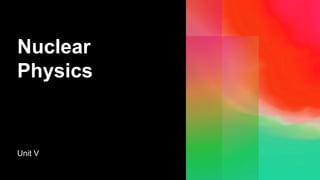
Physics - Basics of Nuclear Physics for Allied students
- 2. Introduction • Z – Atomic Number – Number of Protons • A – Mass Number – Number of Nucleons • Species of nucleus – Nuclide - 𝑧𝑋𝐴 • N – Number of neutrons = A-Z
- 3. Classification of Atomic Nuclei • Isotopes – Same ‘Z’ , different ‘A’ – Same Chemical Prop and Different Physics Prop - 14𝑆28 , 14𝑆29 , 14𝑆30 • Isobars – Same ‘A’ , different ‘Z’ – Different Physics & Chemical Prop - 8𝑂16 , 7𝑁16 • Isotones – Equal number of neutrons - 8𝑂16 , 7𝑁15 - (N=8) • Isomers – Same ‘Z’ and ‘A’ – Different nuclear energy states and internal structure • Mirror Nuclei – Same Mass Number with proton and neutron number interchanged - 8𝑂15 , 7𝑁15 - (For Oxygen – Z=8 & N=7; Nitrogen – Z=7 & N=8)
- 4. General Properties of Nucleus • Nuclear Size : 𝑅 = 𝑟0𝐴1 3 • Nuclear Mass : • Assumed Mass = Zmp + Nmn • Real Mass < Zmp + Nmn • Assumed Mass – Real Mass = Δ𝑚 Mass Defect • Nuclear Density : 𝜌𝑁 = 𝑁𝑢𝑐𝑙𝑒𝑎𝑟 𝑀𝑎𝑠𝑠 𝑁𝑢𝑐𝑙𝑒𝑎𝑟 𝑉𝑜𝑙𝑢𝑚𝑒 = 𝐴𝑚𝑁 4 3 𝜋𝑟0 3𝐴 = 𝑚𝑁 4 3 𝜋𝑟0 3 = 1.816 𝑋 1017 𝐾𝑔 /𝑚3 • Nuclear Charge : Ze
- 5. Models of Nuclear Structure • The Liquid Drop Model • Shell Model • Collective Model
- 6. The Liquid Drop Model • Neils Bohr Proposed I. Nucleus supposed to be Spherical in shape – Symmetrical Surface Tension II. Force of ST – surface of liquid drop; Potential barrier at the surface of nucleus III. Density of LD – independent of its Volume; Density of Nucleus – Independent of its Volume IV. Intermolecular forces – Short Range V. Raised Temperature – molecules evaporates in LD; bombarding – compound nucleus with emitting nuclear radiation VI. LD – oscillate – two smaller drops; Fission is similar
- 7. Semi Empirical Mass Formula • Binding Energy – BE = 𝑎𝐴 − 𝑏𝐴 1 3 − 𝐶𝑍 Z−1 𝐴1 3 − 𝑑𝑍 (N−𝑍) 2 𝐴 ± 𝛿 𝐴 3 4
- 8. Shell Model • Energy level of nucleons – Similar to electron shells in an atom • Proton and Neutron are grouped in shells in nucleus • Shells – Filled – specific number of proton/neutron/both • Number of nucleons in each shell is limited by Pauli’s Exclusion Principle • Shell Model – Independent Particle Model
- 9. Evidence for Shell Model • Nucleus is stable if it contains certain number of Proton/Neutron – Magic numbers – 2,8,20,50,82 & 126 • Inert gasses – closed electron shell – highly stable • Isotopes – isotopic abundance > 60% - magic number category • Tin – (50Sn) has ten Isotopes; Calcium – (20Cs40) has six stable isotopes. ie elements with Z=50,20 are more stable. • Radioactive series – Uranium, Actinium, Thorium – decay to 82Pb208 – stable • Magic number nuclei – cannot accept extra – Shells are closed • Spontaneous neutron emission 8O17, 36Kr87, 54Xe137 N = 8+1, 50+1, 82+1
- 10. Experimentally Confirmed Results • Even – Even Nuclei are more stable than Odd – Odd Nuclei • Able to Predict Total Angular Momenta of Nuclei • Even – Even = Zero • Odd – Even = half-integral total angular momenta • Odd – Odd = Integral Total Angular momenta
- 11. Collective Model • Proposed by A.Bohr, B.R. Mottleson, James Rainwater. • Combines the best features of Liquid Drop and Shell Models • Nucleons exert centrifugal force on the surface of nucleus – permanent deformation to non – spherical shape – surface may undergo periodic oscillations • Drop like properties – Fission • Retains shell model characteristics • 𝑊 = 𝐸𝑟𝑜𝑡 + 𝐸𝑣𝑖𝑏 + 𝐸𝑛 • Even – Even Nuclei – Spherical Shape, Zero Quadrupole Moment; • Odd-Odd , Odd-Even, Even –Odd = Non-spherical Shape, Finite Quadrupole Moment
- 12. Interaction between Energetic Particles and Matter • Heavy Charged Particle • Electrons • The Absorption of 𝛾 – Rays • Photoelectric effect • Pair production • Compton effect
- 13. Ionization Chamber • Charged subatomic particles can ionize gases • Number of ion pairs produced – info about nature of incident particle and their energy
- 14. Ionization Chamber • C – Hollow Cylinder • W –Window • R – Metal Rod • E – Quandrant Electrometer • G – Earthed Guard ring • C – Contains sulphur dioxide / methyl bromide • Ionization current produced – 10-12 to 10-15 Amperes • Pulse amplifier – measures individual particles
- 15. Ionization chamber • Study alpha particles, beta particles, protons, electrons and nuclei
- 16. Proportional Counter • A proportional counter, also known as the proportional detector, is an electrical device that detects various types of ionizing radiation. • Cylinder – Anode – 2 cm dia • Central wire – 10micro-m dia – 20cm length
- 17. Proportional Counter • Pulse size α number of ion pairs – hence proportional counter • 𝐸 = 𝑉 𝑟 log𝑒 𝑏 𝑎 • b – radius of the cylinder • a – radius of the wire • r – distance from center where E is measured • V – positive voltage pf the central wire
- 18. Proportional Counter • Pulse size α number of ion pairs – hence proportional counter •𝐸 = 𝑉 𝑟 log𝑒 𝑏 𝑎 • b – radius of the cylinder • a – radius of the wire • r – distance from center where E is measured • V – positive voltage pf the central wire
- 19. GM Counter
- 21. Particles and Anti Particles
- 23. The Fundamental Interactions Interaction Particle affected Range Relative Strength Particles Exchanged Strong Hardons 10-15 m 1 Mesons Electromagnetic Charged Particles Infinity 10-2 Photons Weak Hardons & Leptons 10-17 m 10-13 Intermediate bosons Gravitational All Infinity 10-40 Gravitons
